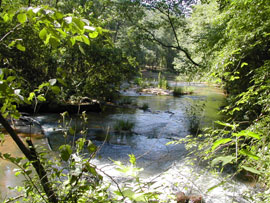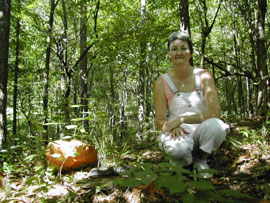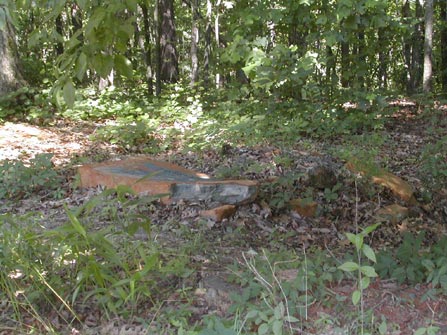Green Burials
Air Date: Week of February 27, 2004
Dying is big business in the United States. Some twenty billion dollars are spent annually on funerals and cemeteries. The past few years have seen an evolution in the funeral industry as individuals try to find creative ways to memorialize their loved ones. As Mitzi Rapkin reports from South Carolina, one man is offering burial services in an outdoor preserve that not only save money, but are ecologically sound, as well.
Transcript
[MUSIC: Thoman Newman "Six Feet Under theme" SIX FEET UNDER SNDTRK (Universal - 2002)]
CURWOOD: Up until the 1900s, burial was a family affair in America. People were laid out in their homes and relatives were the ones who dug and tended to the graves of their loved ones.
Today, funerals and cemeteries are the domain of big business – taking in an estimated 20 billion dollars a year. Now, a South Carolina doctor is reviving old traditions, and creating some new ones. Mitzi Rapkin reports.
[CRICKETS AND BIRDS]
MACDONALD: Now, I think we are at area 19 right here. Oh yeah, see, there you go. Ken…
CORDELL: That’s us?
MACDONALD: That’s our spot, what do you think?
RAPKIN: It sounds as if Babs Macdonald and Ken Cordell are picking out a camping spot but, in fact, they are choosing where they want to be buried. After one visit, they were convinced Ramsey Creek Preserve in Westminster, South Carolina was the place for them.
MACDONALD: Something has to happen to you after you die, and this to me is just the perfect answer.
RAPKIN: It is rare to hear someone so ebullient about their final resting place, let alone making the effort to drive two hours to hike there. As death transforms our bodies, Ramsey Creek is transforming the way burial can be done in America. Dr. Billy Campbell created the memorial preserve in an effort to bring an ecological sensibility to American cemeteries.
|
|
RAPKIN: The memorial preserve is a bouquet of trees and indigenous plants. Campbell doesn’t control the landscape, only the rules for burial. There are no embalmed bodies allowed at Ramsey Creek. People are buried in untreated, biodegradable containers such as wood or cardboard caskets, cotton shrouds or directly in the ground. Cremated remains may be scattered or buried there. If headstones are used, they must lie flat on the ground and be from the same geological strata as the preserve. For Babs MacDonald this is a refreshing option. MACDONALD: I’ve always just wanted to be put in the ground. I mean it’s not natural to be embalmed and put in a casket and all sealed up. RAPKIN: In 2001, nearly two and a half million people died in America. While cremation accounts for 26 percent of that number, it leaves nearly 1.8 million bodies needing burial every year. Most of them will be embalmed, although it is not required by law except in rare cases. Embalming fluid contains chemicals such as formaldehyde which is regulated as an air pollutant and toxic substance by the EPA. Cremation also causes pollution. Many who are cremated still get embalmed depending on when and how the funeral will be carried out. The cremation process itself releases toxins such as dioxin into the atmosphere and burns fossil fuels in the process. Campbell considers cremation the second best option after non-toxic burial, but laments that burial in America is far from natural. CAMPBELL: This whole idea of kind of preserving the bodies with chemicals and putting them in boxes inside boxes under lawns that are meticulously groomed to keep nature out – at once it was alien to my core beliefs. It was almost like we were getting the bodies ready for some afterlife, you know, dress people in their very best clothes and keep them like they’re not dead RAPKIN: In America and Canada, embalming is the norm. Refrigeration can take its place but many funeral homes do not have the capacity to hold more than a few bodies. Muslims and Jews are among the religious groups that already practice non-toxic interment. Churchyards, family farms and historic cemeteries have been the sites of non-toxic burial for centuries. While Ramsey Creek’s apparent novelty may be in resurrecting traditional ways, the core of Campbell’s mission is more ambitious: to save and restore land through ecologically sound burial. CAMPBELL: One of the things I think is attractive about a memorial nature preserve is that people honor places of the dead. And in this setting, where we have people buried throughout the woods, it makes it I think extremely unlikely that even a hundred years from now, or two hundred years from now, anyone would want to come in here and put in a Wal-Mart supercenter. [FLOWING WATER]  (Photo: Mitzi Rapkin) |
RAPKIN: With three ridgelines sloping downward to Ramsey Creek, there are a variety of habitats on the property. In the past, the land was both logged and farmed for cotton. Campbell has restored it to its original wetland, stands of hardwoods and four shoals. Hiking through the preserve, the graves are barely recognizable. They blend into the forest floor like a decomposing leaf.
[FOOTSTEPS] RAMEY: You wouldn’t think it’s a grave, you would think it’s just some rocks laying here with a pile of dirt, you know. It’s pretty with the vegetation. RAPKIN: Bonnie Ramey buried her husband Charles here in 2002. His grave is an oval shaped mound ringed with rocks. Plants and flowers sprout from all sides. Ramey hikes through the preserve every week for peace and meditation.
RAPKIN: The Rameys’ effort to save land was matched by a savings in their wallet. While the $1,950 fee for a plot at Ramsey Creek is comparable to market price, other costs were greatly reduced. According to the National Funeral Directors Association, the average funeral in America costs more than $5,000 not including burial. Caskets from a funeral home typically run from $2,000 up to $20,000. Bonnie Ramey paid $300 dollars for a pine casket. The funeral service held at Charles’ grave cost nothing. Most burials at Ramsey Creek follow this model. Billy Campbell says that the 32-acre preserve is not as big as he would like; but it is the beginning of an innovative way to save land. CAMPBELL: With what we’re doing we’re finding that we attract people who never would give a thousand dollars for a nature preserve. We have found, for example, that we are getting far fewer motivated greens than we would have expected. And we’re getting a lot more people who say they want to be buried in their overalls because that’s the way their granddaddy was buried. MOUNTCASTLE: If you’re from a family that buries in the ground, you’re probably going to bury in the ground. If you’re from a cremation family, that’s all you know and you’re probably going to cremate.
RAPKIN: Meg Mountcastle has been a funeral director for 26 years. She co-owns Mountcastle Funeral Home with her husband in Virginia. She recognizes that burial arrangements are a personal choice made in an ever-expanding field of options. Campbell’s contention that embalming fluid and caskets litter the earth is not lost on her; but she frames it differently. MOUNTCASTLE: I don’t want to say there is not validity in it, but I don’t think it’s a concern as much as maybe they’re saying. At least for me it’s not. But again, it’s to each their own. There’s plenty of room for every idea that’s out there. RAPKIN: And ideas there are. Bob Fells is the External Chief Operating Officer and general counsel for the International Cemetery and Funeral Association. FELLS: Today we are seeing much more of an interest in personalized funerals, personalized burials -- the memorialization concept. People do not want cookie-cutter funerals, they want something that makes a statement about the decedent. RAPKIN: Billy Campbell doesn’t have any bones to pick with the funeral industry; he just sees the potential of another option. CAMPBELL: You know, if we could just get ten percent of the public, of the boomer generation, to decide that they would rather go with a memorial nature preserve, the amount of cash that could be used to save and restore land could make a tremendous difference. RAPKIN: Ultimately, Campbell hopes to see a million acres of land across the United States set aside for memorial preserves. While Ramsey Creek is only a fraction of this, Campbell is working to create a similar project in California. For Living on Earth I’m Mitzi Rapkin in Westminster, South Carolina. Links
|

 Dr. Billy Campbell (Photo: Mitzi Rapkin)
Dr. Billy Campbell (Photo: Mitzi Rapkin)  Bonnie Ramey (Photo: Mitzi Rapkin)
Bonnie Ramey (Photo: Mitzi Rapkin)  A gravesite at Ramsey Creek Preserve. (Photo: Mitzi Rapkin)
A gravesite at Ramsey Creek Preserve. (Photo: Mitzi Rapkin) 



